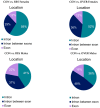Maternal Under- and Over-Nutrition during Gestation Causes Islet Hypertrophy and Sex-Specific Changes to Pancreas DNA Methylation in Fetal Sheep
- PMID: 34573497
- PMCID: PMC8466738
- DOI: 10.3390/ani11092531
Maternal Under- and Over-Nutrition during Gestation Causes Islet Hypertrophy and Sex-Specific Changes to Pancreas DNA Methylation in Fetal Sheep
Abstract
The mechanisms by which fetal programming predisposes offspring to reduced β-cell function later in life are poorly understood. We hypothesized that maternal under- and over-nutrition during gestation would negatively affect offspring pancreas development and alter DNA methylation patterns. Pregnant ewes (n = 78) were fed 100, 60, or 140% of NRC requirements beginning at d 30.2 ± 0.2 of gestation. The fetuses are referred to as CON, RES, and OVER, respectively. Fetal pancreas tissue was collected at d 90 or 135 of gestation or within 24 h of birth. Tissue was preserved for histological (n = 8 to 9 offspring per treatment per time point) and DNA methylation analyses (n = 3 to 4 fetuses per treatment per sex). At d 135, OVER exhibited an increased islet size, reduced islet number, and greater insulin positive area compared with CON (p ≤ 0.03). An increased islet size was also observed at d 135 in RES (p ≤ 0.03) compared with CON. Cellular proliferation was reduced at birth in OVER vs. CON (p = 0.01). In the RES vs. CON females, 62% of the differentially methylated regions (DMRs) were hypomethylated (p ≤ 0.001). In the RES vs. CON males, 93% of the DMRs were hypermethylated (p ≤ 0.001). In OVER, 66 and 80% of the DMRs were hypermethylated in the female and male offspring compared with CON (p ≤ 0.001). In conclusion, changes to maternal diet during pregnancy affects the islet hypertrophy and cellular proliferation of the offspring at early post-natal time points. Additionally, changes in DNA methylation patterns appear to be in a diet-specific and sex-dependent manner.
Keywords: DNA methylation; beta cell function; endocrine pancreas; fetal programming; sheep.
Conflict of interest statement
The authors declare no conflict of interest. The funders had no role in the design of the study; in the collection, analyses, or interpretation of data; in the writing of the manuscript, or in the decision to publish the results.
Figures






Similar articles
-
Fetal and organ development at gestational days 45, 90, 135 and at birth of lambs exposed to under- or over-nutrition during gestation,.Transl Anim Sci. 2017 Feb 1;1(1):16-25. doi: 10.2527/tas2016.0002. eCollection 2017 Feb. Transl Anim Sci. 2017. PMID: 32704626 Free PMC article.
-
Poor maternal nutrition during gestation in sheep alters prenatal muscle growth and development in offspring.J Anim Sci. 2020 Jan 1;98(1):skz388. doi: 10.1093/jas/skz388. J Anim Sci. 2020. PMID: 31875422 Free PMC article.
-
Poor maternal diet during gestation alters offspring muscle proteome in sheep.J Anim Sci. 2022 Aug 1;100(8):skac061. doi: 10.1093/jas/skac061. J Anim Sci. 2022. PMID: 35908790 Free PMC article.
-
Effects of poor maternal nutrition during gestation on ewe and offspring plasma concentrations of leptin and ghrelin.Domest Anim Endocrinol. 2022 Jan;78:106682. doi: 10.1016/j.domaniend.2021.106682. Epub 2021 Sep 7. Domest Anim Endocrinol. 2022. PMID: 34607218
-
The effects of poor maternal nutrition during gestation on postnatal growth and development of lambs.J Anim Sci. 2016 Feb;94(2):789-99. doi: 10.2527/jas.2015-9933. J Anim Sci. 2016. PMID: 27065149 Clinical Trial.
Cited by
-
Developmental Programming of Fertility in Cattle-Is It a Cause for Concern?Animals (Basel). 2022 Oct 3;12(19):2654. doi: 10.3390/ani12192654. Animals (Basel). 2022. PMID: 36230395 Free PMC article. Review.
-
High-Fat Diets Fed during Pregnancy Cause Changes to Pancreatic Tissue DNA Methylation and Protein Expression in the Offspring: A Multi-Omics Approach.Int J Mol Sci. 2024 Jul 3;25(13):7317. doi: 10.3390/ijms25137317. Int J Mol Sci. 2024. PMID: 39000422 Free PMC article.
-
Effects of Maternal Protein Supplementation at Mid-Gestation of Cows on Intake, Digestibility, and Feeding Behavior of the Offspring.Animals (Basel). 2022 Oct 20;12(20):2865. doi: 10.3390/ani12202865. Animals (Basel). 2022. PMID: 36290250 Free PMC article.
-
Fetal Hypoglycemia Induced by Placental SLC2A3-RNA Interference Alters Fetal Pancreas Development and Transcriptome at Mid-Gestation.Int J Mol Sci. 2024 Apr 27;25(9):4780. doi: 10.3390/ijms25094780. Int J Mol Sci. 2024. PMID: 38731997 Free PMC article.
-
Epigenetic modulation of cell fate during pancreas development.Trends Dev Biol. 2023;16:1-27. Trends Dev Biol. 2023. PMID: 38873037 Free PMC article.
References
Grants and funding
LinkOut - more resources
Full Text Sources

